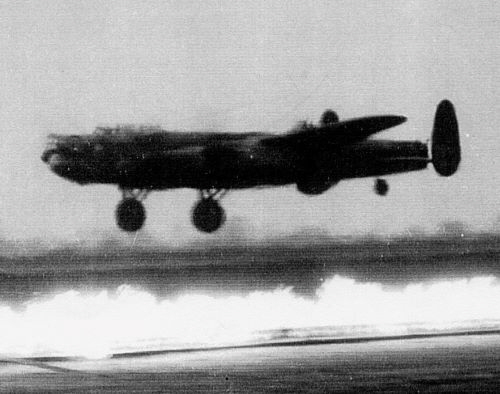Fog Investigation and Dispersal Operation – FIDO

There were 4 FIDO systems operational in Lincolnshire with varying degrees of success from 1944 to the end of the war, RAF Fiskerton, RAF Metheringham, RAF Ludford Magna and RAF Sturgate,
Fog Investigation and Dispersal Operation (FIDO) (which was sometimes referred to as "Fog Intense Dispersal Operation" or "Fog, Intense Dispersal Of") was a system used for dispersing fog and pea soup fog (dense smog) from an airfield so that aircraft could land safely. Those of us that are old enough to recall the days before the 1956 Clean Air Act legislation can well recall these pea soupers when visibility was exceptionally poor and the detrimental effect on the health of the population as a whole was considerable.
The device was developed by Arthur Hartley for British RAF bomber stations, allowing the landing of aircraft returning from raids over Germany in poor visibility by burning fuel in rows on either side of the runway.
The FIDO system was developed at the department of chemical engineering of the University of Birmingham, United Kingdom during the Second World War. The invention of FIDO is formally attributed to Dr John David Main-Smith, an ex-Birmingham resident and principal scientific officer of the Chemistry Department of the Royal Aircraft Establishment at Farnborough, Hampshire
The device consisted of two pipelines situated along both sides of the runway and through which a fuel (usually the petrol from the airfield's own fuel dump) was pumped along and then out through burner jets positioned at intervals along the pipelines. The vapours were lit from a series of burners, producing walls of flame.
The FIDO installation usually stored its fuel in four circular upright tanks built at the edge of the airfield with a low brick bund wall in case of leakage. The tanks were usually encased in ordinary brickwork as protection from bomb splinters or cannon fire
When fog prevented returning Allied aircraft from locating and seeing their runways to land they would be diverted to FIDO equipped aerodromes. RAF night bombers which were damaged on their missions were also diverted to FIDO airfields due to the need to make certain they could land when they arrived.
When FIDO was needed, the fuel pumps were started to pump flammable liquid into the pipe system and a Jeep with a flaming brand lashed to its rear drove fast down both sides of the runway to ignite the fuel at the outlets in the pipes. The burners were sometimes ignited by men on bicycles or by runners on foot. The result was a row of flame along the side of the runway that would warm the air.
The heat from the flames evaporated suspended fog droplets so that there would be a clearing in the fog directly over the runway. This allowed the pilot to see the ground as he attempted to land. Once landed the aircraft would be moved from the runway and dispersed to hard stands around the airfield. The next day the aircraft would be repaired if needed, refuelled and flown back to their home base.
FIDO consumed huge quantities of fuel, as much as 100,000 imperial gallons per hour. Over twice this amount was used by airfields with longer runways such as Carnaby Large fuel storage tanks filled with low-grade petrol and possibly kerosene and other fuel were connected by pumps to provide this fuel to the runway pipes. Although extravagant in the use of fuel consumed, it was felt that the device more than made up for the operating costs involved with the reduction of aircraft losses.
Compiled by David Fell with reference to the excellent book Flying Through Fire by Geoffrey Williams. Photo from my own archive
Pathe News have an informative film produced by the RAF about FIDO in 1946.
FIDO Pathe News 1946 Archive Film
....................
|